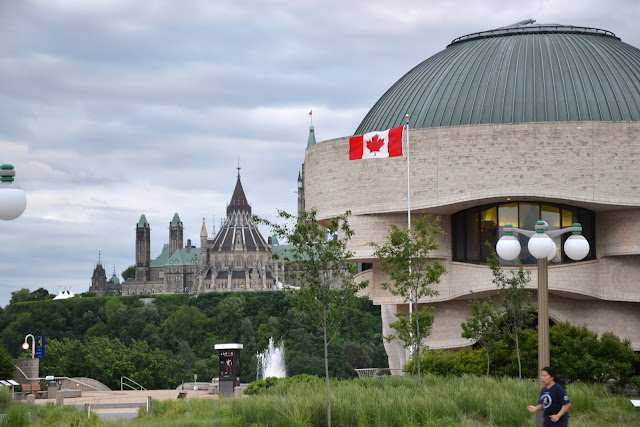This morning the weather permits us to continue our journey down the Ottawa River to the east. At Montreal, the Ottawa River joins the St. Lawrence River. We follow the St. Lawrence River as it continues through low, flat farmland past Trois-Rivieres and then on to Quebec City. In Quebec City we get a bird’s eye view of the heart of the city passing the Plains of Abraham, the Chateau Frontenac and the confluence of the St. Charles River with the St. Lawrence. At this point the St. Lawrence flows on either side of the Iles d’Orleans. We get a great view of the Montmorency Falls and the Basilica of Sainte-Anne-de-Beaupre on the north side of the river. The river begins to widen after the Iles d’Orleans and tidal influence becomes apparent. The Gaspe Peninsula on the south side parallels our journey up the North Shore. Highway 138 winds along the shoreline along our route.
 |
| Farmland south of Ottawa River east of Ottawa |
 | |
| Moving Map on Flat Panal Display in our Diamond Aircraft just east of Montreal |
 | |||
| Montreal |
 |
| St. Lawrence River east of Montreal |
 |
| St. Lawrence River |
 |
| Approaching Quebec City |
 |
| Chateau Frontenac, Quebec City |
 |
| Montmorency Falls just east of Quebec City |
We begin our long journey down the North Shore of the Gulf of St. Lawrence. The Laurentian Mountains come right down to the shoreline. The mountains are clothed in mixed forest. Occasionally one sees shear cliffs of bedrock on the sides of domed mountains. As we proceed north the mountains diminish in height and farming becomes more prevalent. Charlevoix is very pastoral and looks inviting. Tourism and cottages are prominent along this part of the North Shore. The Saguenay River brings a large volume of water into the St. Lawrence at Tadoussac. The land becomes relatively flat the by the time we reach Baie-Comeau. We stop here for fuel. The economy of the towns along this part of the North Shore is tourism, mining and forestry.
 |
| Charlevoix |
 |
| North Shore St. Lawrence |
 |
| Valbaie River |
 |
| Looking north at ferries crossing the Saguenay River |
 |
| Aircraft flat panel showing Saguenay flowing into St. Lawrence; Gaspe Peninsula on the right |
 |
| Short final Baie-Comeau |
The next town of size is Sept-Iles which has a large aluminum smelting facility and shipping terminal. We continue on up the coast over Havre-Saint-Pierre and the Mignan Archipeligo and Bird Sanctuary. At Natashquan the Highway #138 along the North Shore ends. This is where the Lower North Shore begins. The communities between here and just south of Blanc-Sablon rely on boat or air transportation. We fly over many small communities, some of them out on islands. There are roads in most of the communities but they are only for local traffic. The landscape is now shield, lakes and rivers. The rivers have many waterfalls and rapids which are very visible from the plane. Remnants of snow drifts become more and more plentiful.
We arrive in Blanc-Sablon late in the afternoon. We stop here for fuel. We are lucky that there is still someone there to fuel our plane as the fellow was actually just leaving to go to his cabin. The fuel at Blanc-Sablon was very pricy: $2.87 per litre. After refuelling we head a little further along the coast into Labrador then fly across the Strait of Belle Isle (12 miles) to Newfoundland. This is the shortest distance across water between the mainland and the “Rock”. We fly across to the St. Anthony airport which is literally in the middle of no where; 53 km to the town of St. Anthony. There are so few places to build a runway in this landscape. After some searching we finally find a taxi to come and pick us up and take us into town. On the way, we count 27 moose! As we get close to St. Anthony, we see a sizeable ice berg in the one of the bays. We stay overnight at the Grenfell Heritage Hotel. Dr. Grenfell was a prominent physician in Labrador and the Northern Peninsula of Newfoundland.










 Ottawa River east of North Bay
Ottawa River east of North Bay





















